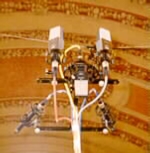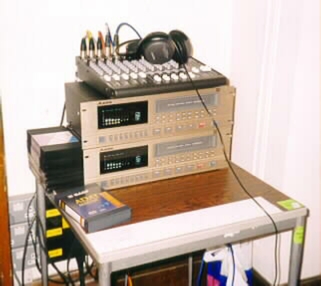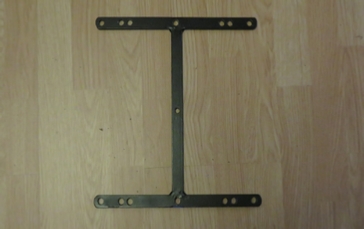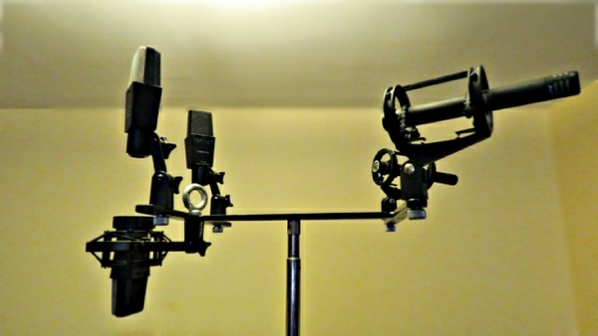Innocent Ear
Microphone techniques for 5.1 Surround Sound
The following article was originally written for and published in Audio Media magazine, September 2000. It has been revised and updated for publication here.
INTRODUCTION
One of the hot topics in audio at the moment is 5.1 surround sound. Whereas the book on stereo has been written for some time, the book on 5.1 is only just beginning to be written. Engineers all over the world are now experimenting with recording in 5.1 This article details our experiments and eventual approach to this subject.
AIMS
As a practising engineer specialising in Classical music, my first thought was whether 5.1 would allow me to continue to record naturally. I must be one of the few audio professionals left on the planet still clinging to the very unfashionabl e and outdated view that a good recording should reproduce the concert hall experience in the listener’s home, as opposed to the modern method of faking some sort of superficially ‘perfect’ sound that doesn’t exist in nature. This is what used to be known as ‘high fidelity’. You don’t need to be a rocket scientist to see that 5.1 offers the potential to recreate much more accurately the venue in which the recording took place. Tests conducted by Holman (1988) and Damaske and Ando (1972) showed that 5 channels is the minimum needed to give a satisfactory impression of a subjectively diffused sound field. 5.1 also overcomes one of the fundamental limitations of stereo recording, namely that all sound, both direct and reverberant, comes out of the (front) speakers. The extra discreet channels give much more scope for engineers to work or fiddle, according to your point of view.
e and outdated view that a good recording should reproduce the concert hall experience in the listener’s home, as opposed to the modern method of faking some sort of superficially ‘perfect’ sound that doesn’t exist in nature. This is what used to be known as ‘high fidelity’. You don’t need to be a rocket scientist to see that 5.1 offers the potential to recreate much more accurately the venue in which the recording took place. Tests conducted by Holman (1988) and Damaske and Ando (1972) showed that 5 channels is the minimum needed to give a satisfactory impression of a subjectively diffused sound field. 5.1 also overcomes one of the fundamental limitations of stereo recording, namely that all sound, both direct and reverberant, comes out of the (front) speakers. The extra discreet channels give much more scope for engineers to work or fiddle, according to your point of view.
PRACTICAL PROBLEMS
After buying the extra equipment necessary to make experimental 5.1 recordings and creating a 5.1 listening room at home where I could hear the results of my work straight away, I had more questions than answers in my mind:
1. Should 5.1 be considered as a completely new mic technique, or should it be thought of as basically stereo with 3 extra channels?
2. Where should the rear mics be placed? Should they be placed way down the hall, or close to the main pair?
3. How important is the center channel? Does it make much difference for audio (Remember the format was originally designed for the cinema mainly to lock dialogue to the screen)?
4. What about stereo compatibility? As in the early days of stereo, mono compatibility was important because most people still had mono listening equipment, as today most people have stereo listening equipment. Would a 5.1 recording either mix down well to stereo or would you need to make a parallel stereo recording? Or could you somehow extract a stereo signal from your 5.1 recording without having to mix down?
POSSIBLE SOLUTIONS
I started by thinking about how to mike up for 5.1. Firstly, I had to decide on a channel configuration. I settled on the obvious one of channel 1 = left front, channel 2= center front, channel 3= right front, channel 4= left rear and channel 5= right rear. Because of my philosophy of recording naturally, I tend to sample the sound at one po int in space as much as possible. After all, this is how we hear. So this meant that any 5.1 setup that I would use had to do the same. Thinking about point 1 above, I started by thinking of the system as stereo with 3 extra channels. I couldn’t really see how 5.1 could be something so radically different, as for Classical audio the front channels would still carry most of the information and the rears reflections from the back of the venue. This meant that I could continue to use the tried & trusted mic techniques that I’ve been using for over a quarter of a century. The problem was how to use the center & rear channels to increase realism?
int in space as much as possible. After all, this is how we hear. So this meant that any 5.1 setup that I would use had to do the same. Thinking about point 1 above, I started by thinking of the system as stereo with 3 extra channels. I couldn’t really see how 5.1 could be something so radically different, as for Classical audio the front channels would still carry most of the information and the rears reflections from the back of the venue. This meant that I could continue to use the tried & trusted mic techniques that I’ve been using for over a quarter of a century. The problem was how to use the center & rear channels to increase realism?
THE CENTER CHANNEL
I made a number of experimental recordings concerning the center channel. As mentioned above, in its original environment, the cinema, the primary purpose (but not exclusively so) of the center channel is to help lock the dialogue to the screen. This is why it’s sometimes known as the dialogue channel. In the recording of Classical music, the center channel at first sight doesn’t appear to be necessary, as all good mic techniques have good imaging. It is well known that coincident techniques such as the Blumlein pair (coincident figure of 8’s at 90 degrees) or M&S produce rock solid center images which you can almost reach out and touch. Even ear spaced techniques such as BDT or ORTF produce good center images. How does a center mic and associated replay channel fit in to this? If you’re using a coincident technique, where would (could) you put a center mic? What about tapping a feed off the left & right front channels and mixing them into the center, thus artificially creating a center channel?
Firstly, I noticed that when people have a center channel in their replay systems at home, they tend to space the left & right front speakers slightly further apart than if they didn’t have a center speaker. That’s understandable as you can have a more impressively wide sound stage without a hole in the middle, great for crash-
Another question is, because the presence of the center channel means that you shouldn’t get a hole in the middle of your recording, would you get better sound by spacing the main mic pair further apart? I tried this by increasing the spacing to 27cm. This didn’t really improve the sound in 5.1, but the stereo version was audibly inferior, with poor central imaging.
REAR MIC PLACEMENT
The next problem concerned the rear mics as in point 2 above. I experimented with positioning the rear mics both far away down the hall from the musicians using different polar patterns and then putting the stand a foot or so behind the main mic stand. Obviously, in the latter case I could only really use rear facing cardioids or shotguns, as anything else would pick up far too much direct sound for the rear channels. The clear winner here for me was rear facing cardioids 40cm or so away from the main pair. When the stand was placed further down the hall, the level as reproduced from the rear speakers was so low as to be virtually inaudible. After raising the level, the sound was disjointed and lacked coherence, particularly when omni’s were used. The rear channels sounded better with rear facing cardioids about 30cm from the front 3 mics. As for spacing, they sounded slightly better at 27cm than at either 20 or 17cm. However, the difference was subtle. I also tried using rear facing short shotguns. The result was largely the same as with cardioids and gave a higher level to the rear channels, but the spread of reverberation was not as good (as one might expect) and neither was the sound quality.

After these experiments, I went to the village blacksmith and had him make a 5.1 mic bar for me. It’s in the shape of an H with the 2 parallel bars spaced apart by 30cm. The width of the 2 bars was also 30cm with holes drilled at 27cm, 20cm (for BDT) and 17cm (for ORTF) together with one in the center. A hole was drilled in the center of the connecting piece to enable the bar to be fixed onto the stand. This enables me to put all 5 mics on one bar supported by a very hefty stand. It also fulfils my criterion of sampling the sound at one point in space as much as possible, as the distance between the front and rear mics is not that much greater than the head.
LEVELS
I reasoned that, if a 5.1 array was going to reproduce a soundfield accurately, then relative levels, particularly from the rear channels, must be crucial. It seemed to me that as I was using 5 identical mics with reasonably identical output levels, that I should set the gain exactly the same for all the mics and let the positioning dictate the levels. This would mimic the way we hear. So the front 3 mics will all pick up roughly the same level, but the rear facing cardioids will naturally pick up less and therefore be at a slightly lower level. I hoped that when replayed, the sound would be as natural as we might hear it live. I wasn’t disappointed.
Another good thing is that all Dolby Digital amplifiers have a set up facility which enables you to accurately set up your speakers in any given listening room. It does this by sending a burst of white noise to each speaker in turn. It is then quite easy to accurately adjust the level to each speaker so that subjectively they are all at the same level. If you want to be even more accurate about it you can always use a sound pressure meter. This means that whatever your domestic arrangements, you should still be able to experience 5.1 in all its glory, unless you put a couple of speakers right behind the sofa or something like that. From the recording engineer’s point of view, this is great, as the listener should get exactly the sound you intended.
STEREO COMPATIBILITY
In the light of the previous experiments, this was an easy question to answer. Because my 5.1 setup is basically a stereo pair with 3 extra channels added, taking the outputs of channels 1 & 3 gave you real, unadulterated, stereo! I did try making a stereo mixdown from all 5 channels, but this proved to be audibly inferior to the straight stereo from channels 1 & 3. So for any future domestic carrier which can have a stereo version of a 5.1 recording, it would be very easy to provide that.
CONCLUSION
After a long period of experimentation, I have concluded that 5.1 is indeed capable of significantly enhancing the realism of the concert hall experience over good old fashioned stereo. In this frontally dominated system designed for the cinema, I have shown (at least to my own satisfaction and that of a few others including fellow engineer and Audio Media contributor Mike Skeet) that it is possible to keep the tried and trusted stereo mic techniques that we have been using for decades and effectively add the 3 extra channels in the way that I have described above. Of course this may well be too simple a solution for some in our often unnecessarily complex world, but I believe that the best solutions are often the simplest and the most elegant. Effectively continuing the work of that great genius of audio, Alan Blumlein (who acknowledged the possibility of extra channels in his famous patent) into the 21st century, 5.1 will hopefully give audio, especially the Classical side, the boost it sorely needs. Now that both DVD and the idea of multi channel sound is already well established with the public at least for cinema, it is up to us engineers to show them how we can enhance their listening experience for music. This, I think, is where the future of audio lies.
Chris Burmajster.
© COPYRIGHT 2000 INNOCENT EAR
